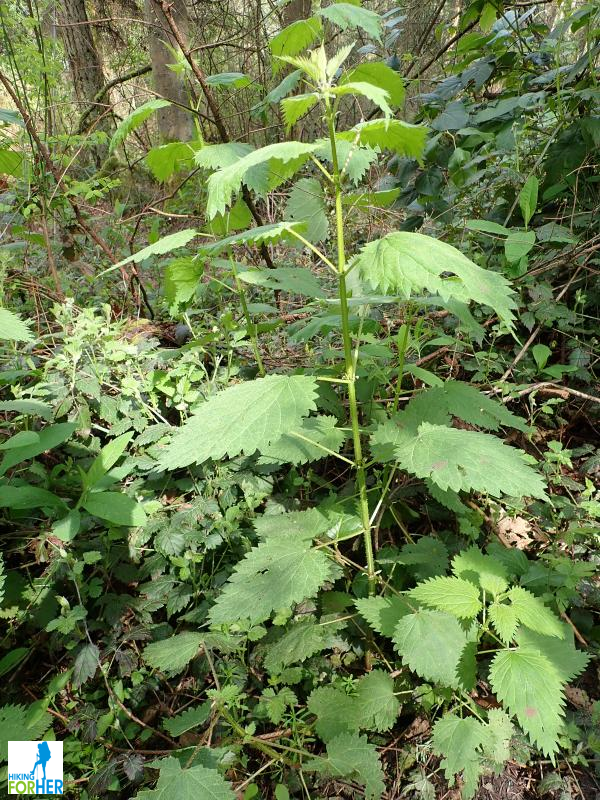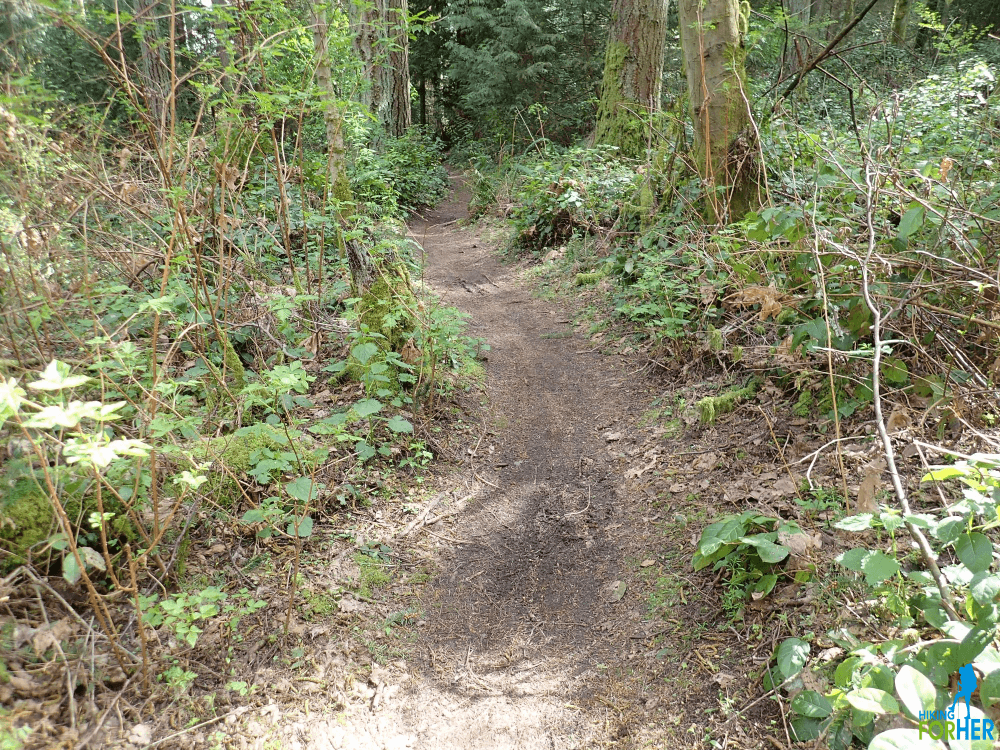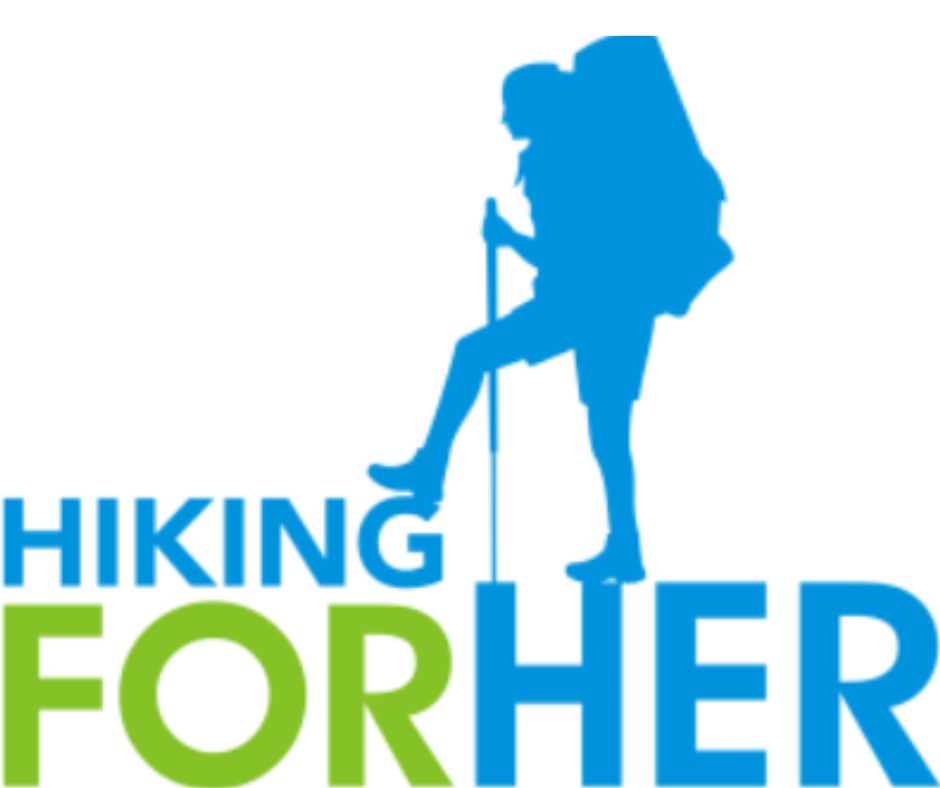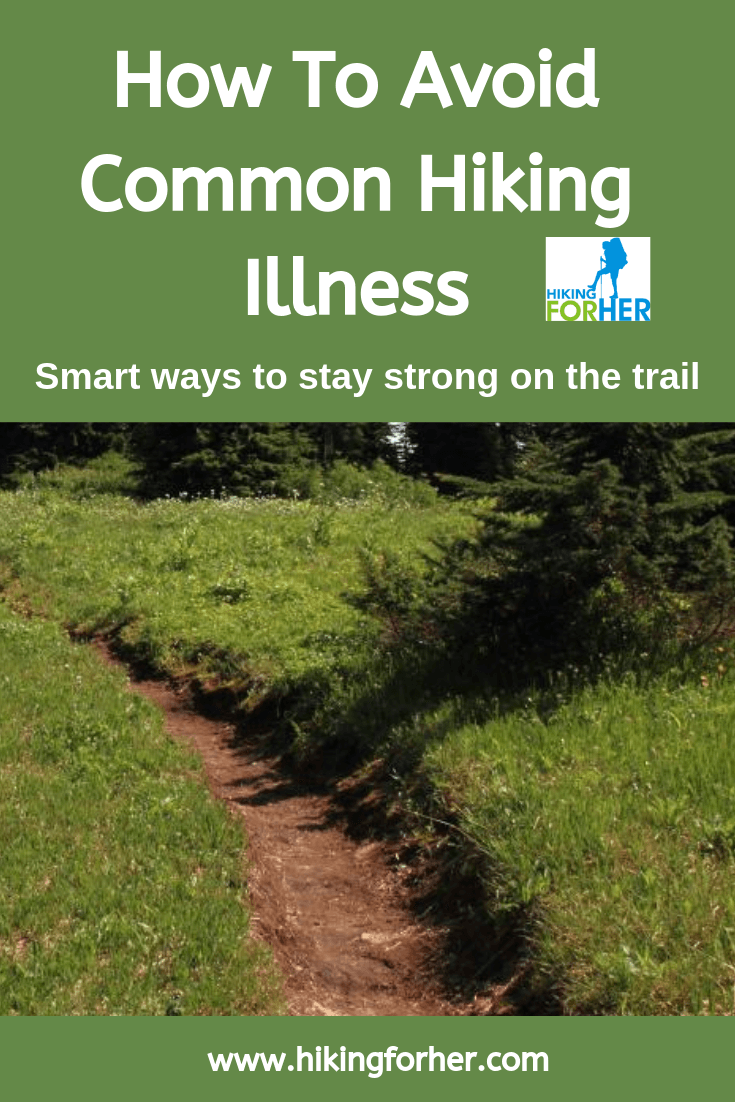Hiking Illness:
What You're Up Against
And How To Prevent It
By Diane Spicer
A common hiking illness list is a great tool to use as you prepare for a day hike or a backpacking trip.
It's important to know the likelihood of running into trouble on the trail!
- Because getting sick on a hike can really take the wind out of your sails (so to speak).
- It's not much fun for your trail companions, either.
So here is the list, arranged from most common to least likely.
No medical advice or recommendations are being given here. Use your own judgement and consult qualified medical providers when faced with hiking illness.
Common hiker illness list
1. Nausea, vomiting, diarrhea (N/V/D)
2. Allergies or reactions (pre-existing or contact with plant toxins)
3. Infections (urinary tract, flu, waterborne such as giardia, broken skin or wounds, respiratory such as common cold)
4. Respiratory illness (asthma attack)
5. Abdominal pain (appendicitis, food toxins, constipation, unknown)
6. Fatigue, exhaustion
7. Cardiac issues
8. Altitude related illness: HAPE, HACE
Would you rather read about hiking injury prevention?
Notice anything about that hiking illness list?
Did you notice that the first three hiking illness categories on the list (covering the majority of sickness a hiker will face on the trail) have something in common?
- Contact with something outside of the body that will cause trouble once it is on, or inside, you.
Symptoms like vomiting and diarrhea mean that your body is trying to rid itself of a poison or a troublesome microorganism.
The same goes for a skin rash, allergic reaction (sneezing, runny eyes, GI changes) or an infected wound (pus is a pile of dead white blood cells warriors).
So this list gives us an excellent clue about how to stay off the list:
- By changing our behavior, and sticking to good hygiene habits, we can minimize our exposure to the most likely troublemakers.
- This in turn reduces our risk of picking up a hiking illness from a trail buddy, contaminated food or water, or other source.
Hurrah!
Where did that list of hiking illness
come from?
Believe it or not, organizations collect detailed statistics on the most common complaints reported by hikers.
The National Outdoor Leadership School (NOLS) is a great example.
Download their free pdf report, written by the Wilderness Medicine Institute, entitled Evidence Informed Wilderness Medicine: What Really Happens Out There?
NOLS pulls together statistics from many sources, including hiker surveys, youth programs, government reports on national park incidents, SAR reports (Search And Rescue) and more.
Fascinating reading if the subject of hiking illness is important to you!
No medical advice about diagnosis or treatment is being given on this website.
Instead, let's focus on what you as a smart hiker can do to prevent hiking illness from setting up shop in your body.
You've got some great tools: mindfulness, planning, behavioral changes and smart decisions.
So let's put them to work to prevent you from coming down with hiking illness.
Tips to avoid and prevent
common hiking illness
Plan to stay healthy on the trail (and stay off that list) with tips in these categories:
- hand hygiene
- poop and pee kit
- guard your mucous membranes
- sharing food
- your food choices
- clean water
- safe camp kitchen
- clean kitchen camp
- botanical knowledge
- self care
- avoid UTIs
- say no to yeast infections
- deal with ear infections
- prompt wound care
- flu
Scrupulous hand hygiene is the first line of defense
against hiking illness
I am constantly amazed grossed out by the lax hand hygiene practiced by both day hikers and backpackers.
Unwashed hands transmit pathogens (germs like bacteria and viruses) that are common in feces, respiratory secretions (coughs, sneezes, nose picking) and gastrointestinal secretions (saliva, vomit).
- Just because you can't see them doesn't mean they aren't on your hands! Trust me, they greatly outnumber the cells in your own body.
Here's the best thing you can do to keep yourself from getting sick on a hike:
Take scrupulous hiking hand hygiene seriously.
In fact, put together a hygiene kit and carry it in an outside pocket of your backpack, within easy reach, and use it after you defecate, pee, sneeze, or cough.
Before you put anything in your hands to your lips, or unscrew your water bottle/hydration pouch, or prepare and handle food, be sure your hands are clean.
That makes having a ready supply of these hand cleansing options:
- Alcohol based hand sanitizer in convenient sizes
- Soap flakes like these
- Unscented liquid soap like Dr. Bronners
Poop and pee preparation
Let's not be coy: female hikers pee and poop.
That's why we need to use a well stocked, easy to use bathroom hygiene kit each time we eliminate body wastes.
Peeing is straightforward, because urine from a healthy body is sterile, meaning you don't have to worry about it contaminating surface water or your hands.
- Drip dry, or use a pee rag (a dedicated small towel or bandanna that hangs to dry on the outside of your backpack).
- A quick squirt of that hand sanitizer mentioned above is all you need afterwards.
Feces is a whole different universe, teeming with microbes that you don't want to introduce to your mucous membranes or gut.
Put together that bathroom hygiene kit, and even in the absence of a bathroom, use it.
My kit includes these items:
- The Deuce trowel, unbelievably lightweight and strong enough to dip a cat hole in rocky ground so I can Leave No Trace. And it will last a lifetime, something a cheap plastic trowel won't do.
- Unscented pre-moistened towelettes or wipes (see above; some hikers prefer to carry toilet paper, but I find that keeping it dry is a challenge in wet weather)
- Hand sanitizer or soap flakes (above)
- Two resealable plastic bags: a larger one to hold those items and a smaller one to receive used wipes until you can dispose of them in an appropriate location.
You can also carry your menstrual supplies in this kit, and dedicate a separate resealable bag to hold them.
Mucous membrane integrity
Say what now?
Mucous membranes: the doorways into your bloodstream and within spitting distance (so to speak) of your internal organs.
- Anywhere you are open to the external environment, you have a wet, protective membrane that is protected by your immune system in some way: secretions, white blood cells, special adaptations to kick out intruders.
- Think eyes, nose, mouth, vagina, anus.
Staying well hydrated (tips coming up) keeps those membranes in top shape to protect you.
Keeping your dirty fingers away from those membranes also helps you avoid hiking illness.
So if you're a nail biter or a cuticle chewer, or love to wipe sweat and bugs out of your eye area with your fingers, make a conscious choice to change your behavior on the trail.
Eating with dirty fingers allows microbes to bypass your natural defenses, depositing them into your digestive track where they can begin to multiple.
- Sometimes as often as doubling their numbers every 20 minutes!
- Your immune system might have a tough time outrunning them if you're tired from multiple days of hiking and camping.
Intimate behaviors with your partner or yourself with dirty hands?
- Just say no!
To share food and avoid hiking illness, pour it
When you pass around a bag of trail mix or nuts, pour some into your (hopefully clean) hand rather than reaching in for a big, germy handful.
Don't be shy about requesting a "pour" rule on any hike or backpacking trip.
It's one of the first things I bring up in a group setting as a health precaution.
- Be your own advocate for avoiding hiking illness, even if it comes across as a bit bossy!
- To avoid having to confront a "reacher" who ignores your request, carry your own snacks.
Sharing beverages out of a common flask or bottle?
Using your own spork but eating out of a common cook pot?
Rethink it!
- You don't want to fall victim to your trail buddy's normal flora, especially when you're already ingesting different water organisms and are being challenged by your physical exertions.
Could it be a food sensitivity
or reaction to something new?
If you're having vague symptoms involving your gut, like gas or pressure, ask yourself:
Have you introduced anything new or different into your hiking menu?
It could be that you're having a reaction to something in the food you've eaten.
- Food for thought (thoughts on food and digestion, actually)
Use clean drinking & cooking water
to avoid hiking illness
The days of drinking out of a seemingly pristine surface water source are over, unless you are in a very special place such as the Arctic or seldom traveled routes with access to glacial melt.
To protect yourself from organisms that would love to use your gut as real estate, treat all water as suspect, and have a water treatment plan - plus the gear to carry it through.
- Read a complete discussion of your choices here.
Waterborne illness like giardiasis is something you do not want to face, as it will impede your ability to get back to the trailhead.
- Pain, gas, weird stools, weakness ... yuck, right?
- More about giardia
Keep a safe camp kitchen
Be mindful when you take out your backpacking stove.
- Most hikers experience burns related to contact with boiling water used during cooking.
- Burns can turn into infection in an outdoor environment.
This sounds like common sense because it is:
Remove tripping hazards like rocks or hiking gear from the area where you're going to prepare and consume your food.
- Move slowly and purposefully around hot water!
Make sure your backpacking stove is the right one for your needs, and that your control over the flame is exactly what you want.
Keep a clean camp kitchen
Anyone preparing food (including you on a solo hike) should deploy the hand hygiene tips above.
And anyone consuming food should also have clean hands, to prevent self inoculation with microorganisms found in soil, water, human and animal sources.
Don't let flies buzz around your uncleaned pots and dishes. Force yourself to get those dishes done ASAP.
Use an efficient and effective system for washing dishes, like this one.
Dayhikers, don't think you're immune to food borne illness.
- Read these tips on how to carry your food safely on a day hike.
Know what you're touching
Field guides are indispensable for so many reasons.
For the topic of hiking illness, these fact filled books are going to prevent you from contacting plants with oils and toxins that will damage your skin.
You probably already know the triad of "poisons":
- ivy
- sumac
- oak
But can you identify them?
Make sure you glance at the plants at your pee spot before you squat.
Look at what you're putting your hands and legs on during a snack break.
Don't burn dried plant material entangled with deadwood without identifying it first.
- Horror stories about camp smoke from poison ivy entering the respiratory tract are too horrible to share here.
- Ditto for stories about using abundant glossy leaves as toilet paper.
Plan ahead in case your canine trail buddy or hiking group runs into plant poisons.
- Have some type of skin irritation relief in your first aid kit, such as calamine lotion or pre-contact/post-contact wipes like these.
 Stinging nettle will cause a fierce sensation, so avoid it
Stinging nettle will cause a fierce sensation, so avoid it
Stay strong with proactive self care
Don't work against yourself by becoming physically or mentally depleted. That's when pathogens can gain the upper hand to create a hiking illness in your body.
Hydrate regularly, using these tips.
Eat often, using these trail snacks rather than candy bars.
Plan a good backpacking menu, using these hiking nutrition tips and backpacking food ideas.
Take a break when you feel stressed, hungry, tired, upset or confused.
- Becoming extremely fatigued, or pushing yourself to the point of exhaustion, weakens your immunity.
If you're feeling depleted and can take a zero day (rest day, lounging day, layover, whatever you want to call it), do it!
- Hydrate, rest, immerse yourself in your surroundings as you rejuvenate and regain your strength.
More self care tips for hikers can be found here!
Avoid UTIs on the trail
Many females have already "enjoyed" the experience of a urinary tract infection (UTI).
So you may already be on the "let's skip that party" wavelength with me.
Here's something to note:
- As female hikers, we have two things going against us regarding the likelihood of developing a urinary tract infection: time and hydration.
TIME
You are in control of your time on the trail.
If you have to pee, take time to do it before it becomes urgent.
- Retaining urine in your bladder sets up a good environment for microbes to begin to multiply.
Got too many miles to cover and can't be bothered to squat?
- Read my review of the TinkleBelle female urinary device that allows you to stand up and pee, thereby saving you precious time locating a pee spot.
HYDRATION
You also control your hydration level.
This in turn dictates how often you need a pee stop: water in wants to come out, sooner rather than later.
If you strictly regulate your water intake to make needing to pee less likely on the trail, consider this: concentrated urine also makes the possibility of a UTI increase.
And dehydration is no friend to a hiker's cells, leading to headaches, constipation, sore muscles and lack of energy.
So please drink often on the trail!
Vaginal yeast infection avoidance
Just as with UTIs, many female hikers have dealt with the invasion of the yeast prior to hitting the trail.
- Itchiness
- Burning
- Goopy discharge
On a backpacking trip, you're going to experience a dip in the strength of your immune system as you challenge your body day after day, eating different food and immersing yourself in trail dirt.
This is especially true if you're diabetic, pregnant, or taking antibiotics.
But there are a few things you can do to keep yourself out of yeasty trouble.
Try these:
- Wear an unscented, non irritating panty liner and change it daily, if not more often (be sure to pack them out), to keep your mucuous membrane area clean.
- Use unscented pre-moistened baby wipes to clean yourself after peeing, pooping and sex (pack them out, or burn them each night if fires are permitted).
- Choose the right hiking underwear (a comfortable cut in moisture wicking, breathable, nonchafing materials) with these tips.
If you already know that you're prone to yeast infections, don't forget to tuck an over-the-counter anti-fungal cream or ointment into your first aid kit.
Don't blow off ear infections or ear aches
From personal experience, I have high motivation to warn you off going to high altitudes when your ears are bothering you.
- This is especially important if you are coming from sea level and plan to ascend quickly, or even relatively quickly, several thousand feet in a day.
It's better to reschedule your hiking plans for when your ears are back to normal, than to contend with the discomfort of ruptured eardrums or massive infection.
Use these tips to differentiate between inner ear infections and middle ear infections.
Deal with wounds immediately
Anything that breaks your skin creates a highway for pathogens.
- Soil microorganisms, as well as your normal skin microbes, can be nasty little beasts when they gain entry to your bloodstream.
Take the time to cleanse and cover broken skin, rather than hiking "just one more mile" with an open blister.
If you burn or scald your skin, whether from ultraviolet radiation or the cooking stove, focus your attention of what you have in your first aid kit to address the problem (tips below).
- Clean it out.
- Cover it up.
- Keep it dry.
- Look at it every day for signs of infection: redness, swelling, pain, red streaks leading away from it, pus
Insect bites can become infected if you scratch them with dirty fingernails, so keep your nails as short and as clean as possible.
- Insect repellent tips here
Carry an oil based, unscented skin lotion to prevent cracked cuticles and dry skin patches. I like Aveeno for this purpose.
Take flu-like illness seriously
Yes, there's a major amount of suckage coming your way when you experience body aches, chills, vomiting and all the rest of the "flu like" package on a hike or backpacking trip.
So you deserve some sympathy.
You also deserve to make the decision: try to hike out under reduced power, or lay down and let nature take its course.
Only you know your usual reaction to this type of infection, and only you can gauge how long it might take to feel strong enough to get your hiking boots and backpack on again.
Your hiking buddies will need to support you, regardless of which direction you're headed, by encouraging you to:
- Swallow lots of clear, clean, cool water, or plenty of herbal tea if that's what you crave.
- Curl up in your sleeping bag for napping, rest and recuperation.
- Give your gastrointestinal tract a break by switching to liquid nourishment or very watered down oatmeal and non spicy foods.
If your first aid kit includes over-the-counter remedies to suppress your symptoms, now is the time to consider using them if you want to keep hiking.
Don't be shy about asking for what you need.
- Pushing yourself on the trail is only going to make things worse in the short term.
- No awards are given for "sickest hiker ever".
And remember, even a few of the astronauts were plagued with the flu while encapsulated in a tin can (viruses love to travel), and they managed to complete their missions.
This too shall pass :/
And what if it's not the run-of-the-mill flu?
You may be looking at a longer course of illness that will require some outside help to deal with, either rescue or intervention.
- Watch for a rigid abdomen, increasing pain, fever and other messages from your body that it's not just routine flu.
- Deploy your personal locator beacon if necessary.
Your medical history and hiking illness
It's important to note that your medical history comes right along with you on every hike, so pre-existing conditions are a responsibility you need to take seriously.
- Always be sure you have enough prescription medications, supplements, aids or anything else you need for self care for the duration of your day hike. Plus a bit extra in case you're delayed.
- On a backpacking trip, it's wise to pack a few days' extra supply to cover yourself, because you just never know what the trail holds in store for you.
Be a good trail buddy by alerting your companions to any medical issues you have that could make illness more likely, such as asthma, diabetes or food sensitivity.
A special note to thruhikers
about hiking illness
Many U.S. long trails have become incredibly popular, the Appalachian Trail and the Pacific Crest Trail in particular.
This puts extra pressure on campsites and hikers: crowded, stressed conditions create breeding grounds for infectious hiking illness such as norovirus and hepatitis.
Think strategically about your surface water sources, camp kitchen location, and sleeping spot.
Many other hikers have spit, peed, pooped, thrown up and had sex right where you're making camp.
- And they've left you lots of invisible presents: bacteria, viruses, parasites and more.
It's in your best interest to take all of the precautions we've just discussed, beginning with impeccable hand hygiene.
And please use the strongest water treatment approaches to eliminating viruses: boil your water for several minutes, or use a filter with a tiny pore size. When in doubt, double treat it.
- Water treatment is not the place to cut corners to save money or weight on a thruhike, IMHO.
Knowledge is power
on the hiking trail
 Use the power of knowledge on your next hike to stay well
Use the power of knowledge on your next hike to stay wellThat hackneyed phrase applies to hiking illness as well as outdoor navigation and trail techniques, but I find it to be especially useful as a mechanism to prevent hiking illness and injuries.
So I implore you to carve out some time to get educated about what hiking illness looks and feels like, and learn how you can deal with getting sick on a hike.
It's better to have a plan and never use it, than to need one and not have a clue - on top of feeling sick. Don't do that to yourself!
Read some articles
The REI Co-op website is a good source of knowledge for hikers.
- Here's a link to their First Aid Kit Checklist.
It's great to have a first aid kit in your backpack, but do you know how and when to use everything in it?
Take a class
Learn how to deal with your own solo hiking illness as well as how to be there for your hiking buddies when they suffer abdominal pain, infections or allergies.
REI Co-op is a great source for low key, informative and inexpensive classes, including this one:
- Women's First Aid Essentials: What's In Your Kit?
And this one: Preparing for the Unexpected - Outdoor Emergency Basics.
- More info on REI classes here
Hiking illness avoidance
That's a smart strategy, dear hiker.
You want to hike, not huddle in a whimpering heap beside the trail.
Use the proactive tips on this page to keep yourself strong (and upright).
- Simply by keeping your hands clean you're well ahead of the game.
Hiking Illness Any Hiker May Face
|
I get emails all the time about what I wear, eat, carry and love to use on the trail. That's
why I provide affiliate links to you: the best gear that I use myself and have seen used by other hikers is instantly
available for your consideration, and the gear company sends a few
pennies per dollar to this reader-supported hiking website. There is no added cost to you! Everyone ends up a winner: Great gear for you, strong gear companies, and more free hiking tips for everyone. Thanks very much for your support. It's warmly and sincerely appreciated. It also helps send these hiking tips to all your virtual trail buddies around the globe. |
 |



